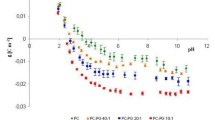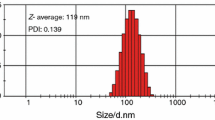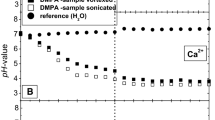Summary
The present study examined the effect of membrane cholesterol on liposome-mediated calcium phosphate precipitation in metastable aqueous solutions (2.25 mM Ca2+ and 1.5 mM inorganic phosphate) at 22°C, pH 7.4 and 240 mOsm. The liposomes were prepared from 7:2:X molar mixtures of phosphatidylcholine, dicetylphosphate, and cholesterol (x=0, 1, 5, or 9) and contained either 0 or 50 mM encapsulated phosphate. The membranes were made permeable to Ca2+ by addition of the cationophore, X-537A. Changes in external Ca2+ concentration were used as the principal monitor of the course of precipitation. Without encapsulated phosphate, 7:2:X liposomes (with or without ionophore) induced no precipitation. With 50 mM encapsulated phosphate and in the presence of ionophore, precipitation significantly depended on the cholesterol level in the membrane. At 0 and 10 mole% cholesterol, precipitate developed rapidly both within and outside the liposomes. At 35 and 50 mole% cholesterol, no observable intraliposomal precipitation occurred, and extraliposomal precipitation started only after an induction period of 24 hours. Delayed extraliposomal precipitation also took place in PO4-containing liposomes without added ionophore. In this latter case, however, cholesterol was essential for this precipitation to occur with the optimum level being around 10 mole%. Suppression of ionophore-mediated intraliposomal precipitation at higher cholesterol levels could be related to the inflexible cholesterol molecules making the membrane more rigid, thereby restricting Ca-ionophore transport. This restriction could be reversed with ethanol. Delayed extraliposomal precipitation in the absence of added ionophore (or at higher cholesterol levels in its presence) could be explained by seeding from low, unobserved levels of intraliposomal precipitate formed during slow, unfacilitate Ca2+ leakage into the liposomal interior.
Similar content being viewed by others
References
Bangham A, Standish M, Watkins J (1965) Diffusion of univalent ions across the lamellae of swollen phospholipids. J Molec Biol 13:238–252
Okimasu E, Nobori K, Kobayashi S, Suzaki E, Terada S, Utsumi K (1987) Inhibitory effect of cholesterol on interaction between cytoplasmic actin and liposomes, and restorative effect of high osmotic pressure. Cell Struct Funct 12(2):187–195
Hitzemann RJ (1987) Effect of ganglioside GM1 on the order of phosphatidylcholine cholesterol multilamellar liposomes. A fluorescence polarization study. Chem Phys Lipids 43(1):25–38
Chauhan A, Chauhan VP, Brockerhoff H (1986) Phosphatidylcholine and cholesterol inhibit phosphatidate-mediated calcium traversal of liposomal bilayers. Biochim Biophys Acta 857(2): 283–286
Szebeni J, Toth K (1986) Lipid peroxidation in hemoglobin-containing liposomes. Effects of membrane phospholipid composition and cholesterol content. Biochim Biophys Acta 857(2): 139–145
Eanes ED, Hailer AW, Costa JL (1984) Calcium phosphate formation in aqueous suspensions of multilamellar liposomes. Calcif Tissue Int 36:421–430
Eanes ED, Hailer AW (1985) Liposome-mediated calcium phosphate formation in metastable solutions. Calcif Tissue Int 37:390–394
Eanes ED, Hailer AW (1987) Calcium phosphate precipitation in aqueous suspensions of phosphatidylserine-containing liposomes. Calcif Tissue Int 40:43–48
Heywood BR, Eanes ED (1987) An ultrastructural study of calcium phosphate formation in multilamellar liposome suspensions. Calcif Tissue Int 41:192–201
Eanes ED, Hailer AW, Heywood BR (1988) Modulation of calcium phosphate formation by phosphatidate-containing anionic liposomes. Calcif Tissue Int 43:226–234
Hope MJ, Bally MD, Mayer LD, Janoff AS, Cullis PR (1986) Generation of multilamellar and unilamellar phospholipid vesicles. Chem Phys Lipids 40:89–107
Eanes ED, Heywood BR (1989) Liposome technology in biomineralization research. In: Myers H (ed) New biotechnology in oral research. Karger, Basel, p 54
Murphy J, Riley JP (1962) A modified single solution method for the determination of phosphate in natural waters. Anal Chim Acta 27:31–36
Rouser G, Siakotos AN, Fleisher S (1966) Quantitative analysis of phospholipids by thin-layer chromatography and phosphorus analysis of spots. Lipids 1:85–86
Johnson SM (1973) The effect of charge and cholesterol on the size and thickness of sonicated phospholipid vesicles. Biochim Biophys Acta 307:27–41
Yeagle PL (1989) Lipid regulation of cell membrane structure and function. FASEB J 3:1833–1842
Anderson HC (1969) Vesicles associated with calcification in the matrix of epiphyseal cartilage. J Cell Biol 41:59–72
Bonucci E (1970) Fine structure and histochemistry of calcifying globules in epiphyseal cartilage. Z Zelleforsch Mikrosk Anat 103:192–217
Anderson HC, Cecil R, Sajdera SW (1975) Calcification of rachitic rat cartilage in vitro by extracellular matrix vesicles. Am J Pathol 79:237–254
Peress NS, Anderson C, Sajdera SW (1974) The lipids of matrix vesicles isolated from bovine fetal epiphyseal cartilage. Calcif Tissue Res 14:275–281
Wuthier RE (1975) Lipid composition of isolated epiphyseal cartilage cells, membranes and matrix vesicles. Biochim Biophys Acta 409:128–143
Sajdera SW, Franklin S, Fortuna R (1976) Matrix vesicles of bovine fetal cartilage: metabolic potential and solubilization with detergents. Fed Proc 35:154–155
Wuthier RE (1977) Electrolytes of isolated epiphyseal chondrocytes, matrix vesicles and extracellular fluid. Calcif Tissue Res 23:125–133
Vaananen HK (1980) Calcium incorporation in matrix vesicles isolated from chicken epiphyseal cartilage. Calcif Tissue Int 30:227–232
Wuthier RE (1982) The role of phospholipid-calcium-phosphate complexes in biological mineralization. In: Anghileri LJ, Tuffet-Anghileri AM (eds) The role of calcium in biological systems. CRC Press, Boca Raton, p 41
Author information
Authors and Affiliations
Rights and permissions
About this article
Cite this article
Skrtic, D., Eanes, E.D. Effect of membrane cholesterol on calcium phosphate formation in aqueous suspensions of anionic liposomes. Calcif Tissue Int 50, 55–60 (1992). https://doi.org/10.1007/BF00297298
Received:
Revised:
Issue Date:
DOI: https://doi.org/10.1007/BF00297298




